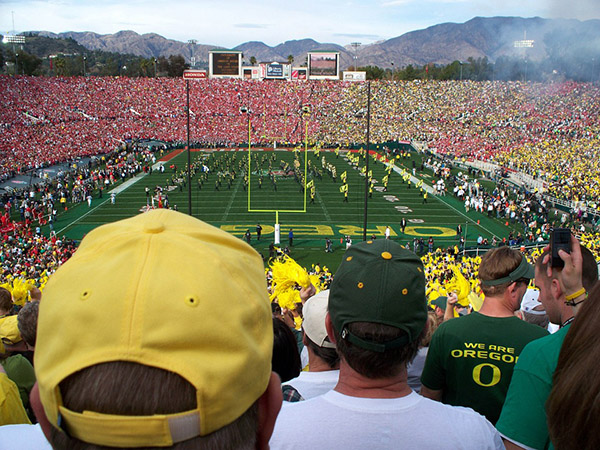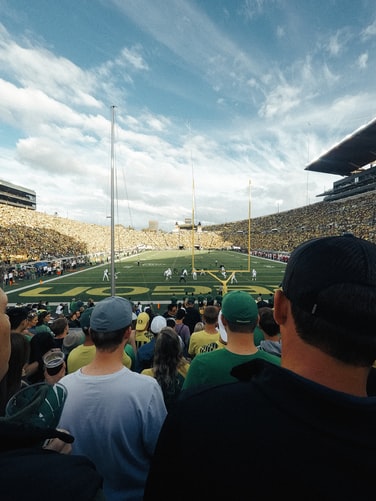The University of Oregon is an institution that has contributed a lot to the state and local area, from community outreach to creating jobs and generating revenue. However, easily the biggest ongoing student and local-enticing event staged throughout each year is that of NCAA Division I, Pac-12 Conference games, featuring the hometown Oregon Ducks. Naturally, the collegiate track and field team is very well known, but it’s America’s favorite sport, football, that continues to be the highlight. It’s also the state of play of college football and the intense rivalries that have developed, such as Oregon vs. Washington, that has seen such a tremendous amount of evolution over the decades.
Building to the modern craze of college football
IMAGE SOURCE: Pixabay
Prior to World War I, and for several years afterward, baseball was America’s game. In the 1920s, however, college football boomed across the nation, with universities putting up colossal football stadiums modeled on the grand old arenas of the ancient Greeks and Romans. The incredible number of stadiums built through the 20s led to a huge increase in attendance, with it eclipsing 10 million by the 1930s.
The home of the Oregon Ducks came several decades later, well after World War II. In 1966, the university broke ground for what would become Autzen Stadium, ironically being named after Oregon State University alumni Thomas E. Autzen. The stadium opened in 1967, eventually being renovated and expanded in 2002, now officially seating 54,000.
Relatively late to the big field collective of teams, the growth of the University of Oregon into an NCAA powerhouse has been relatively slow but exploded under a hot run of top-10 finishes. Given the rich athletic history of the state of Oregon, this isn’t a surprise. In fact, the run of success into the early 2010s resulted in nearly one-in-five of Oregon’s Facebook users becoming fans of college football. It’s not just over the internet that college football, including the Oregon Ducks, has evolved across the US.
In fact, a surge of money and fandom can be traced back to the mid-80s, when college football rights suddenly entered a deregulated landscape. While much of the media foretold doom, in reality, the Rose Bowl alone has ended up costing nearly as much to broadcast that the entire NCAA package once did – even when adjusted for inflation. Such changes even saw the University of Texas go from making less than $20 million in 1999 to over $100 million 13 years later.
The evolved world of being a Ducks fan
IMAGE SOURCE: Unsplash
While the stadium experience is unrivaled, Oregon alumni and fans across the country don’t have to find the niche radio stations or travel all the way to the Autzen Stadium to watch their team anymore. In fact, even though these last two years saw a 17 percent decrease in subscribers, the national Pac-12 Network still boasts nearly 15 million subscribers.
Of course, sports teams across the world have figured out ways to capitalize on their fandoms, and even though the NCAA really, really wants college football to seem like an amateur sport, teams merchandise like crazy. The Oregon Ducks now stand among the ten biggest teams for licensing royalties, with the hundreds of licenses bringing in close to $5 million each year. That’s not to mention the $88 million, 11-year deal struck with Nike back in 2017.
Modern fans are happy to watch online, buy all of the merchandise, but most importantly, engage with the sport with their fellow fans online. Fantasy college football leagues are wildly popular, with many people taking to the online offering, but some still playing in-person within communities. Furthermore, fans now have Facebook groups, YouTube channels, Subreddits, and Twitter to share highlights and keep the conversation going.
Further expansion can be achieved
The NCAA has fought against its ‘student athletes’ earning from their name, image, and likeness for decades, to the chagrin of millions of football players, pundits, and fans. Now popular college football players will be allowed to earn money for doing promotions and even from their own social media platforms – but still not earn a salary. The league should be embracing of this, promote popular stars, and help them to grow their public and online presence as it’ll only draw more eyes to the NCAA product.
With the above issues finally put to bed, allowing those who create the attraction for the league to earn while doing so, many more avenues open up for players and brands. In fact, most other sports have been featured as online slot titles as can be seen on Betway’s extensive list, including soccer with its 11 Champions slot and the live table game Football Studio. However, football has been slow here with a lack of options in this area, so it wouldn’t be a surprise to see the NFL expand into here and maybe even the NCAA further down the line.
While there’s a huge market for this area of entertainment, the one that fans were once familiar with were the video gaming options. Found predominantly on consoles like the PlayStation and Xbox, Electronic Arts’ college football games were very popular, but eventually concluded when the use of college athletes’ images was disputed. Now, there’s room to create a new game, with Bloomberg reporting that EA will restart the series, likely to be called EA Sports College Football, in 2023. If deals are struck, this could also promote the sport.
College football has evolved greatly over the last few decades, from the spectacle itself to what it means to be a fan. However, as the NCAA has opened up to allow its stars to earn, there are still even more possibilities to explore.






